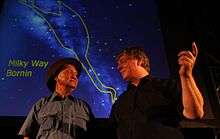Ray Norris (astrophysicist)
Ray Norris is an astrophysicist and science communicator, based at the CSIRO Australia Telescope National Facility, and is well known for his work on Aboriginal Astronomy.

Early life
Ray Norris was born in London and grew up in Brookmans Park, Hertfordshire, England in 1953. He attended high school at St. Albans School and then went to Cambridge University, where he received an honours degree in theoretical physics.
He then went to the Jodrell Bank Observatory of the University of Manchester where he received his PhD in radio-astronomy in 1978, working on astrophysical masers. At the same time, he started to develop an interest in the archaeoastronomy of Stonehenge and other megalithic observatories, joined a group of students led by Clive Ruggles and spent several years surveying the stone circles of the British Isles.
Career
He moved to Australia in 1983 to work for the CSIRO Australia Telescope National Facility. He was appointed as head of astrophysics in 1994, and deputy director in 2000. In 2001 he led the successful bid for Australian astronomy under the Australian federal government’s “Major National Research Facilities” program, and then became director of the Australian astronomy MNRF. In 2005 he resigned from management positions to return to research.
Writing
In 2011, Norris published his first novel, Graven Images.[2]
Aboriginal Astronomy
Norris is well known for his work on Aboriginal Astronomy,[3] and is an adjunct professor in the department of Indigenous Studies at Macquarie University. His work has featured in many radio and TV programs, including ABC TV's Message Stick,[4] and ABC Radio National's The First Astronomers.[5] In August 2009 he featured in a two-man The First Astronomers show with Wardaman elder Bill Yidumduma Harney at the Darwin Festival.[6][7]
Astrophysics
Norris leads the ATLAS project,[8] imaging the faintest radio galaxies and star-forming galaxies in the universe, to understand how they form and evolve. He also leads the EMU project, operating on the new ASKAP telescope to survey of the sky at radio wavelengths. He also researches cosmology and dark energy.[9]
Sources
- http://www.atnf.csiro.au/people/rnorris/
- http://science.uniserve.edu.au/faces/norris/norris.html
- http://www.emudreaming.com/about.htm
- Norris, R.P. & Hamacher, D.W., 2009,"The Astronomy of Aboriginal Australia", In "The Role of Astronomy in Society and Culture", edited by D. Valls-Gabaud & A. Boksenberg. Cambridge University Press, pp. 39-47.
- "Emu Dreaming" by Ray Norris & CIlla Norris, ISBN 978-0-9806570-0-5
- ABC TV Message Stick transcript on web
- ABC Radio National "The First Astronomers" transcript on web
- Ri Aus - people in Science
External links
- Ockhams Razor ABC Radio National "Ockhams Razor" podcast and transcript on Ray Norris's work, presented by Robyn Williams
References
- ↑ The First Astronomers, 2009, Darwin Festival
- ↑ Graven Images ISBN 978-0-9806570-1-2
- ↑ Norris, R.P. & Hamacher, D.W., 2009,"The Role of Astronomy in Society and Culture"
- ↑ ABC TV Message Stick
- ↑ ABC Radio National The First Astronomers
- ↑ First Astronomers on YouTube video of Ray Norris & Bill Harney in the First Astronomers in Darwin
- ↑ The First Astronomers, 2009, Darwin Festival
- ↑ The ATLAS project homepage
- ↑ Cosmology ABC Catalyst segment on Cosmology, with Ray Norris, Lawrence Kraus, & Brian Schmidt